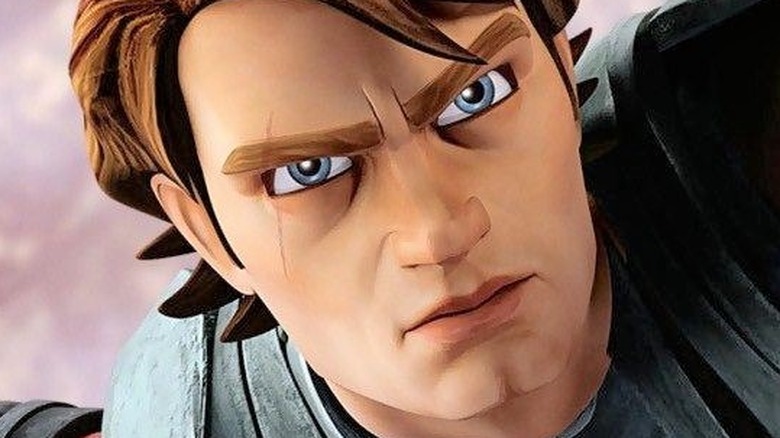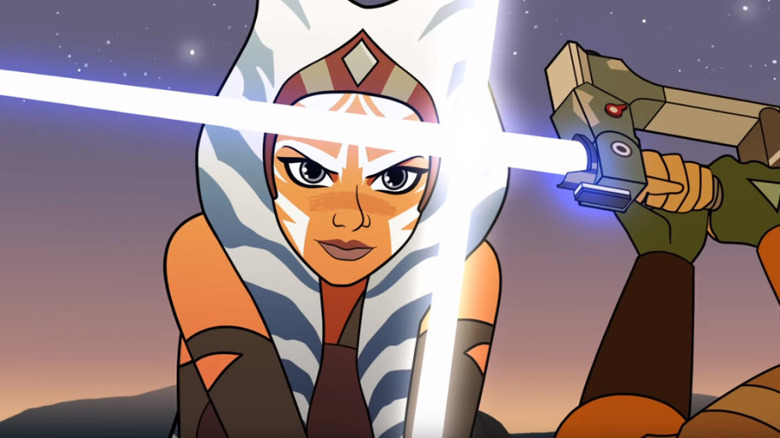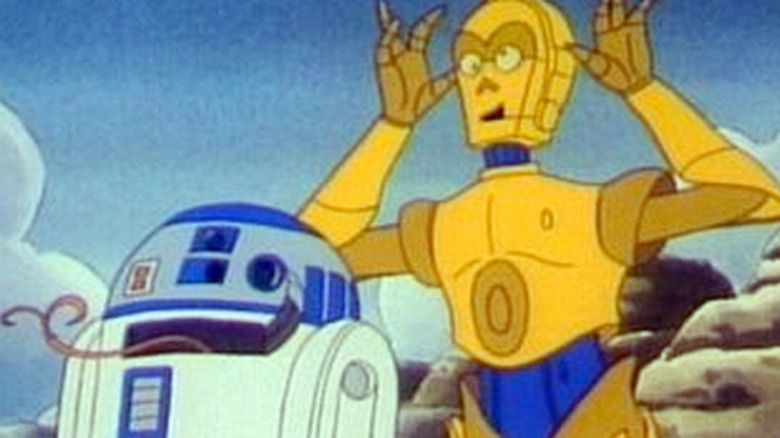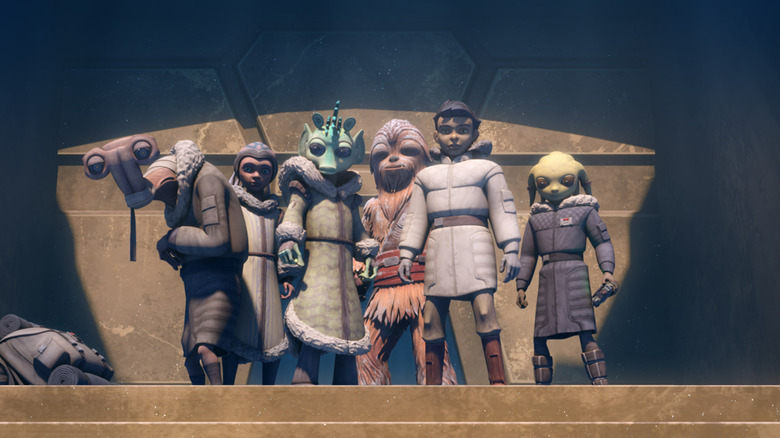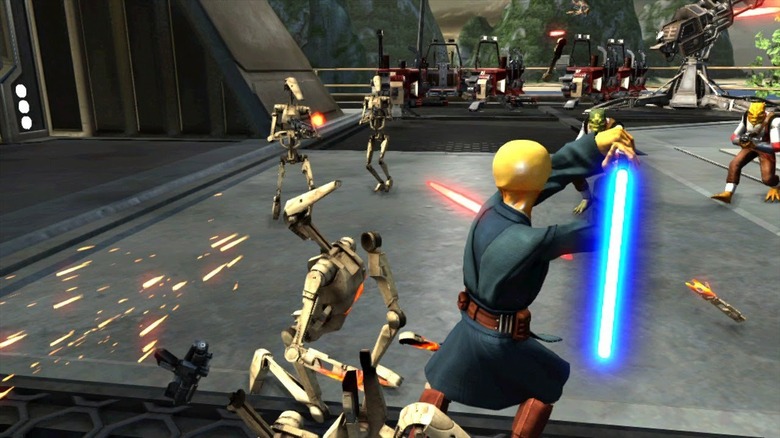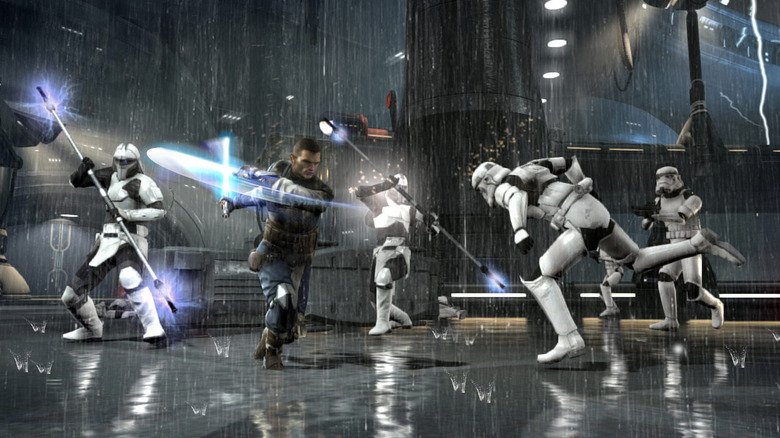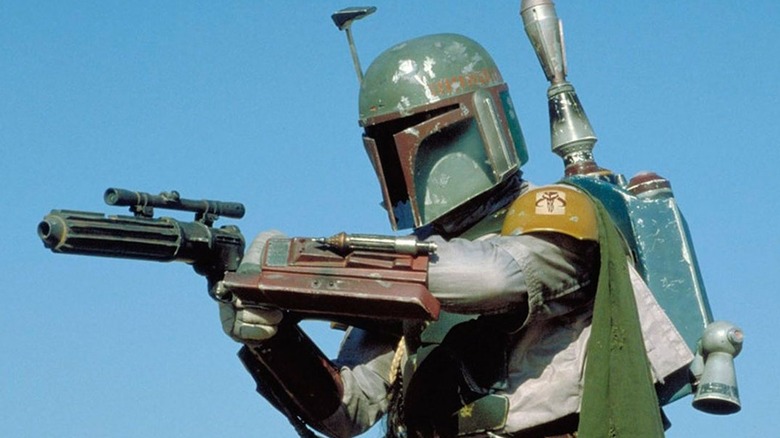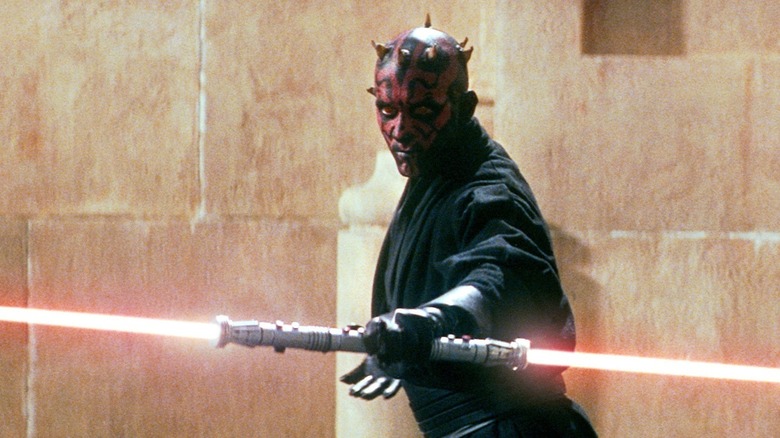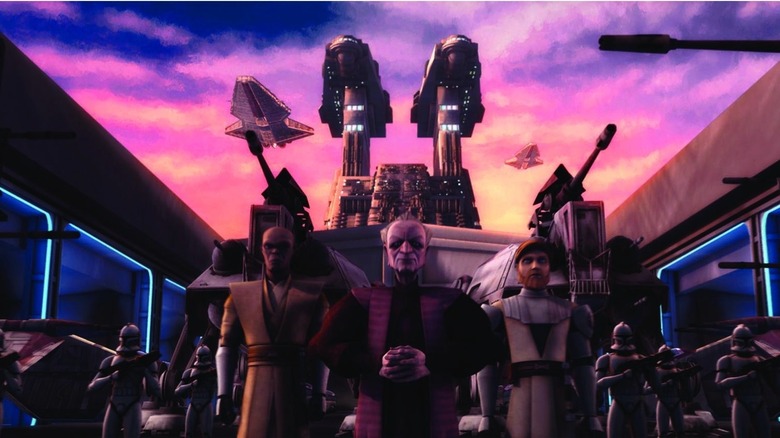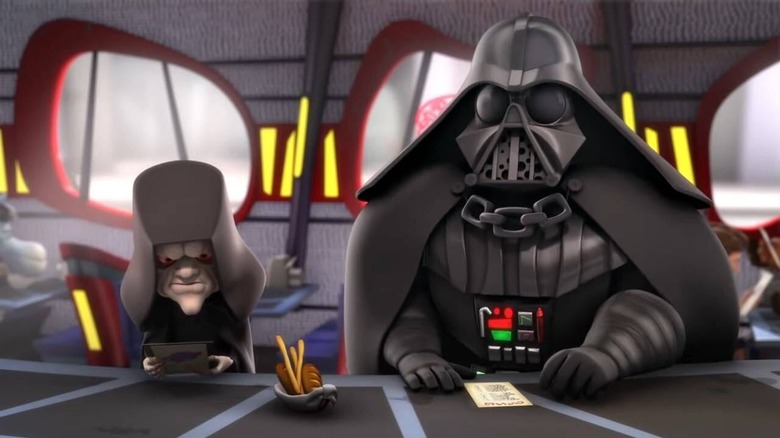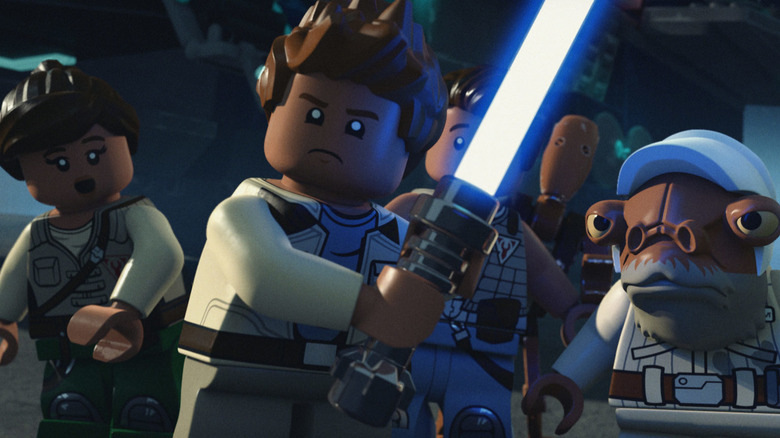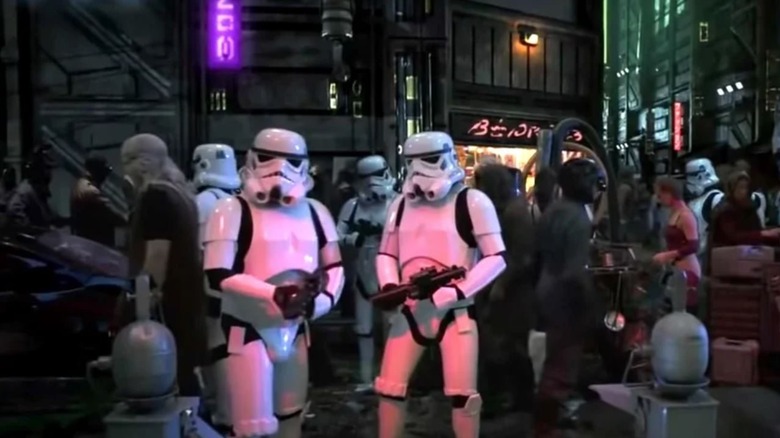The Biggest Forgotten Failures Of Star Wars
For over four decades, the "Star Wars" franchise has proven to be enduringly successful as a major media entity, producing everything from films and books to video games and TV shows. As a result, it's easy to assume that anything with the "Star Wars" logo on it is destined to become a pop culture phenomenon.
But in reality, not everything that's emerged from this galaxy far, far away has gone on to become popular. In fact, the franchise has created a number of productions that were outright failures. Some of these projects misfired so badly that we've all just opted to pretend they don't exist instead of confronting them as being part of the same series that's given us acclaimed movies like "The Empire Strikes Back" and "The Last Jedi." From horrible TV shows to video games that didn't live up to the hype, these forgotten failures prove "Star Wars" is just as capable as any property of producing stuff that doesn't click.
Forces of Destiny was full of flaws
When Disney bought Lucasfilm, it was clear the franchise needed to reaffirm the value of "Star Wars" to its modern, young audience. One way the studio attempted to accomplish this was by launching the "Forces of Destiny" media project, which would encompass short films and a doll line. Largely aimed at young girls, the productions starred the various women of the "Star Wars" movies and cartoons — such as Jyn Erso, Ahsoka Tano, and Princess Leia — with the individual short films containing brief appearances by other figures from the franchise, such as the porgs or Hondo Ohnaka.
But the project didn't last long, with the "Forces of Destiny" shorts only running for two seasons. Given that "Star Wars" so often seems to have a Midas touch, you'd think "Forces of Destiny" would be bulletproof. However, this big media endeavor just didn't get the kind of positive response necessary to keep going for years on end, and YouTuber Jenny Nicholson has provided the most thorough autopsy over why the project didn't work.
Specifically, Nicholson noted the lack of both doll customization and interactions between the "Forces of Destiny" characters in the shorts most likely doomed the property. She also pointed out how the line struggled by being seemingly designed more for the nostalgia of older fans rather than what modern-day youngsters might want. With these drawbacks, "Forces of Destiny" quickly went quiet.
Star Wars: Droids was too silly
If you thought "Star Wars" didn't enter the world of kid-oriented animated television until the 21st century with titles like "Star Wars: The Clone Wars," you wouldn't be alone. After all, Lucasfilm has largely buried their first foray into this genre, one that came all the way back in the 1980s. That's when "Star Wars: Droids" attempted to make waves in the world of Saturday morning programming.
However, the show — which focused on the exploits of C-3PO and R2-D2 — struggled for a variety of reasons. For example, according to SyFy Wire, the series had a pretty hefty price tag, with each episode running between $500,000-$600,000. On top of that, none of the side characters were really clicking. "The secondary characters that [the droids] were involved with were not really strong characters," artist Brian Lemay told SyFy Wire. "They were just these characters that were thrown in to carry them through an adventure of sorts, and ... it had limited basis where you do your three episodes of the one storyline and then you go on to the next one and then you go to the next one, and it's like, 'Okay, we get the idea."
Plus, the family-friendly show lacked any sort of edge. Future "Star Wars" cartoons aimed at youngsters wouldn't be afraid to spice things up with explosions or even impalements. "Droids" had no such flourishes. The man behind C-3PO, Anthony Daniels, even once complained, "You can't put a custard pie in my face because of what they call 'imitative behavior.' They don't want children saying, 'Oh, we saw it on the cartoon, we thought it was okay.'" No wonder the program didn't last more than a single season.
This unmade Clone Wars spinoff just vanished
While "Star Wars: The Clone Wars" was on the air, plans actually got underway for the show to spin off into another animated program. A series of episodes focusing on a collection of young Padawans aired during the series' fifth season in early 2012, and it was meant to establish a new group of characters who would star in their own show. The adolescent protagonists were Petro, Katooni, Byph, Ganodi, Zatt, and Gungi, with each character belonging to a different species (Gungi was a wookiee, for example.) The episodes introducing these figures centered on the younglings – with the help of Ahsoka Tano and a wise droid voiced by David Tennant — trying to form their own lightsabers, only to have the exercise interrupted by space pirate Hondo Ohnaka.
There was enough confidence in this gaggle of children that the episodes were initially supposed to air as a single TV movie before leading into a TV show, mirroring the way the 2008 "Clone Wars" program was introduced to the world. However, for reasons unknown, this storyline aired as a quartet of traditional episodes while the spinoff was put on the backburner. This was in spite of the program being a passion project for George Lucas. The production fell further into the rearview once Disney bought Lucasfilm and started their own slate of kid-oriented "Star Wars" cartoons. Some unmade "Star Wars" projects have exploded with a lot of drama, but this untitled "Clone Wars" spinoff is one misfire that just fizzled out.
Kinect Star Wars gave us a really bad song ... and that's it
With the creation of Xbox's Kinect, a new world of video game possibilities suddenly opened up. Gaming that relied on your body movements rather than a controller — it was a prospect that seemed so exciting. It wasn't long before thoughts turned to how "Star Wars" could utilize this. After all, "Star Wars" and video games have been a lucrative pairing for decades now, and this fictional universe had lots of potential avenues for immersing gamers in a storyline that you had to get up and move with.
Unfortunately, rather than using the Kinect controllers to make a new action-adventure title, LucasArts produced "Kinect Star Wars," a grab bag of different play modes, ranging from being a Padawan who fights enemies to a bunch of dance-offs. Despite trying to do so much, "Kinect Star Wars" failed to connect with the general public, and critics remained unimpressed with the title. Some praise was offered for parts of the gameplay, but it just didn't come together like it was supposed to. Despite all the pre-release hype and potential, "Kinect Star Wars" proved to be a forgettable entry in the library of Kinect titles.
Eventually, it turned out the biggest lasting impact of this game was in one of the dance-off tunes, "I'm Han Solo." This parody of "Ridin' Solo" became infamous — with The A.V. Club calling it "one of the worst pieces of 'Star Wars' licensing ever — a far cry from the kind of reception the game was supposed to receive.
Nobody wanted to buy The Force Unleashed II
For a moment, it looked like "Star Wars: The Force Unleashed" was the next big step for the franchise after the prequel trilogy launched. The beloved 2008 video game followed the tale of Starkiller, the hidden apprentice of Darth Vader, and this premise seemed like it could inspire tons of compelling storytelling for years to come. However, much of that potential was sucked away by its sequel, "The Force Unleashed II." This 2010 title received mixed marks from critics, with much of the criticism being directed at the writing and, especially, at an awkward attempt at a cliffhanger ending.
However, many "Star Wars" properties have come up short critically before going on to spawn further sequels and spinoffs. The real kiss of death for this video game was its sales numbers, which proved to be underwhelming given all the pre-release hype for "The Force Unleashed II." With all these factors at play, the continuing importance of "The Force Unleashed" began to diminish. Eventually, this once-promising new avenue for "Star Wars" storytelling sputtered out completely, as the Disney purchase of Lucasfilm put a priority on newly created projects that didn't feature Starkiller. Even without that merger, though, it's doubtful "The Force Unleashed II" generated enough of a positive response to keep this series going for much longer.
We never got a Boba Fett movie
Initially, the second "Star Wars" spinoff movie after "Rogue One" wasn't going to be Han Solo's origin tale. Instead, it was supposed to be a Boba Fett feature. The incredibly controversial Josh Trank was once set to helm the production, but this particular title got put on the backburner once Trank departed the project. The filmmaker opened up in May 2020, explaining, "I quit because I knew I was going to be fired if I didn't quit."
However, this wasn't the end of the story for Fett's solo movie. For a brief moment in May 2018, it looked like the production got a second lease on life when "Logan" director James Mangold reportedly stepped in to helm the project. But this revival turned out to be short-lived. In the wake of "Solo: A Star Wars Story" coming up significantly short at the box office, spinoff "Star Wars" movies were put on hold in favor of expanding the franchise through event TV shows on Disney+. This meant the "Boba Fett" movie was once again kicked to the curb.
Eventually, Fett would make his way into newer "Star Wars" media through the second season of "The Mandalorian" and the upcoming "The Book of Boba Fett." But as for seeing the character in his own solo feature film, that ship has sailed, despite there being so many attempts to turn the proposed project into a reality.
Those failed plans to re-release the movie in digital 3D
For one brief moment at the start of the 2010s, it looked like theatrical 3D re-releases of classic movies were about to become a big thing. With the original "Lion King" becoming a surprise hit when it was released in 3D in September 2011, the stage seemed set for a series of 2012 3D re-releases to make a similar killing at the box office. These included "The Phantom Menace 3D," which was planned as the start of an ambitious push to re-release all six original "Star Wars" movies on the big screen in a new dimension.
However, "The Phantom Menace 3D" didn't quite blow the doors off the box office. Sure, its worldwide gross was enough to push the lifetime haul of "The Phantom Menace" past the $1 billion threshold, but that was its greatest accomplishment. After a decent opening weekend, it made just less than half of what "The Lion King 3D" accumulated at the domestic box office. Autumn 2013 release dates were set for 3D re-releases of the other two "Star Wars" prequel films, but they were eventually pulled after Disney bought Lucasfilm and overhauled the entire trajectory of "Star Wars" media. As a result, those ambitious plans of re-releasing the "Star Wars" saga in 3D have become as unrealized as the full potential of theatrically re-releasing movies in digital 3D.
The Clone Wars can't compare to the TV show
Today, "Star Wars: The Clone Wars" is known as a TV show that took major risks by focusing on unsung supporting characters in the franchise and even exploring some outright esoteric concepts, like Anakin Skywalker and friends encountering physical manifestations of the Force. But you have to walk before you can run, and most animated programs begin their runs with more awkward episodes that reflect everyone involved trying to figure out the tone of the show they're working on. Rarely, though, do these more imperfect episodes play out on the big screen. But such was the case for the theatrical film "Star Wars: The Clone Wars."
Released in 2008, "The Clone Wars" was meant to serve as a feature-length pilot for the series. However, the film's animation style could never hope to compete with the kind of visuals seen in its competitors — movies like "WALL-E" or "Kung Fu Panda." Worse, this movie utilized a more juvenile sense of humor and dialogue that later seasons of "The Clone Wars" would jettison. The whole project was quite poorly thought-out and didn't even result in much money for its producer. "The Clone Wars" was a certified box office underperformer, cementing it as an underwhelming start to what would become a beloved TV show.
Star Wars: Detours has been completely forgotten
George Lucas got along so well with the team behind the trio of "Robot Chicken Star Wars" specials that he assembled the group in the late 2000s for a new sci-fi project. This was "Star Wars: Detours," an animated TV show that would take a satirical spin on many of the series' beloved characters. Clips of the program were shown at "Star Wars" Celebration in 2012, and they included such antics as Obi-Wan Kenobi being a con man and Greedo impersonating Lando Calrissian in order to secure a girlfriend.
Just two months after the world discovered "Detours," Disney bought Lucasfilm, and the whole landscape of "Star Wars" entertainment changed. Disney had loads of plans for the franchise, but none of them revolved around "Detours." Despite 40 episodes of the show being completed, the program was shelved, with Seth Green reaffirming throughout the years that Lucasfilm just didn't see the show fitting in with their more serious-minded plans for "Star Wars." Rumors continue to persist that "Detours" will eventually drop on Disney+ in the near future, but otherwise, "Detours" has fizzled out despite initially getting a major push.
Does anyone remember The Freemaker Adventures?
LEGO and "Star Wars" have turned out to be a match made in heaven. The two pop culture properties have been working together for decades now on everything from toys to video games to even a cameo appearance in the initial "LEGO Movie." So, why wouldn't there eventually be plans to turn LEGO "Star Wars" into an ongoing TV show? Well, such a creative endeavor emerged through "The Freemaker Adventures," which followed a trio of siblings who get swept up in the greater battle between the Rebel Alliance and the Galactic Empire.
The show, to date, is the only instance of a LEGO "Star Wars" property doing an ongoing TV program in a traditional seasonal format, with most other televised LEGO "Star Wars" properties emerging as either TV specials or as a miniseries. And given that "The Freemaker Adventures" didn't set the world on fire, that's not surprising. The show wasn't exactly a massive flop, but it was nowhere near as impactful as other animated shows like "The Clone Wars," and it didn't attract the kind of fanbase that the LEGO "Star Wars" video games have. Thus, the show only lasted two seasons, a sharp contrast to how LEGO "Star Wars" toy sets have been bestsellers for decades now.
Star Wars: Underworld was the right show at the wrong time
Originally, the next step for the "Star Wars" franchise after "Revenge of the Sith" wasn't a sequel trilogy but exploits in television. First, "The Clone Wars" would begin airing in 2008, and then a live-action "Star Wars" TV show — later revealed to be titled "Star Wars: Underworld" — would debut shortly after. The program was set to explore all kinds of nooks and crannies of the galaxy far, far away, with everything from how Han and Chewie met to the origin story of Palpatine set to be featured on the show. The whole program had grand ambitions and was a passion project for George Lucas.
However, "Star Wars: Underworld" never got off the ground for a simple reason: money. The budgetary problems of pulling off a production of this scale on a cable or basic network TV budget proved too massive to overcome. Lucasfilm executive Pablo Hidalgo would also later note on Twitter that George Lucas being unable to expand his Grady Ranch property to accommodate soundstages also ground the show to a halt. Nowadays, programs like "The Mandalorian" have made "Star Wars" on TV an expected sight. Perhaps "Star Wars: Underworld" was just a project ahead of its time.
